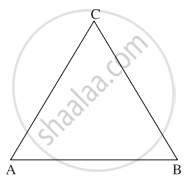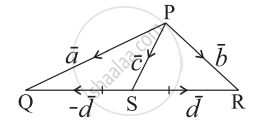Advertisements
Advertisements
प्रश्न
If two sides of a triangle are `hat"i" + 2hat"j" and hat"i" + hat"k"`, find the length of the third side.
उत्तर

Let ABC be a triangle with `bar"AB" = hat"i" + 2hat"j", bar"BC" = hat"i" + hat"k"`.
By triangle law of vectors
`bar"AC" = bar"AB" + bar"BC"`
`= (hat"i" + 2hat"j") + (hat"i" + hat"k")`
`= 2hat"i" + 2hat"j" + hat"k"`
∴ l(AC) = `|bar"AC"| = sqrt(2^2 + 2^2 + 1^2) = sqrt9` = 3 units
Hence, the length of third side is 3 units.
APPEARS IN
संबंधित प्रश्न
If \[\overrightarrow{a}\], \[\overrightarrow{b}\], \[\overrightarrow{c}\] are the position vectors of the vertices of a triangle, then write the position vector of its centroid.
If a vector makes angles α, β, γ with OX, OY and OZ respectively, then write the value of sin2 α + sin2 β + sin2 γ.
Write the position vector of a point dividing the line segment joining points A and B with position vectors \[\vec{a}\] and \[\vec{b}\] externally in the ratio 1 : 4, where \[\overrightarrow{a} = 2 \hat{i} + 3 \hat{j} + 4 \hat{k} \text{ and }\overrightarrow{b} = - \hat{i} + \hat{j} + \hat{k} .\]
If \[\overrightarrow{a} = \hat{i} + 2 \hat{j} - 3 \hat{k} \text{ and }\overrightarrow{b} = 2 \hat{i} + 4 \hat{j} + 9 \hat{k} ,\] find a unit vector parallel to \[\overrightarrow{a} + \overrightarrow{b}\].
Find a unit vector in the direction of \[\overrightarrow{a} = 2 \hat{i} - 3 \hat{j} + 6 \hat{k}\].
If \[\overrightarrow{a} = x \hat{i} + 2 \hat{j} - z \hat{k}\text{ and }\overrightarrow{b} = 3 \hat{i} - y \hat{j} + \hat{k}\] are two equal vectors, then write the value of x + y + z.
If \[\left| \overrightarrow{a} \right| = 4\] and \[- 3 \leq \lambda \leq 2\], then write the range of \[\left| \lambda \vec{a} \right|\].
In a regular hexagon ABCDEF, A \[\vec{B}\] = a, B \[\vec{C}\] = \[\overrightarrow{b}\text{ and }\overrightarrow{CD} = \vec{c}\].
Then, \[\overrightarrow{AE}\] =
The position vectors of the points A, B, C are \[2 \hat{i} + \hat{j} - \hat{k} , 3 \hat{i} - 2 \hat{j} + \hat{k}\text{ and }\hat{i} + 4 \hat{j} - 3 \hat{k}\] respectively.
These points
Find the components along the coordinate axes of the position vector of the following point :
P(3, 2)
Find the components along the coordinate axes of the position vector of the following point :
S(4, –3)
In Figure, which of the following is not true?
OABCDE is a regular hexagon. The points A and B have position vectors `bar"a"` and `bar"b"` respectively referred to the origin O. Find, in terms of `bar"a"` and `bar"b"` the position vectors of C, D and E.
Check whether the vectors `2hati + 2hatj + 3hatk, - 3hati + 3hatj + 2hatk` and `3hati + 4hatk` form a triangle or not.
In the given figure express `bar"c"` and `bar"d"` in terms of `bar"a"` and `bar"b"`.

If `|bara|` = 3, `|barb|` = 5, `|barc|` = 7 and `bara + barb + barc = bar0`, then the angle between `bara` and `barb` is ______.
In a parallelogram ABCD, diagonal vectors are `bar"AC" = 2hat"i" + 3hat"j" + 4hat"k" and bar"BD" = - 6hat"i" + 7hat"j" - 2hat"k"`, then find the adjacent side vectors `bar"AB" and bar"AD"`.
If `|bar"a"| = |bar"b"| = 1, bar"a".bar"b" = 0, bar"a" + bar"b" + bar"c" = bar"0", "find" |bar"c"|`.
If ABC is a triangle whose orthocentre is P and the circumcentre is Q, prove that `bar"PA" + bar"PB" + bar"PC" = 2bar"PQ".`
Find the angle between the lines whose direction cosines are given by the equations 6mn - 2nl + 5lm = 0, 3l + m + 5n = 0.
State whether the expression is meaningful. If not, explain why? If so, state whether it is a vector or a scalar:
`bar"a".(bar"b" xx bar"c")`
State whether the expression is meaningful. If not, explain why? If so, state whether it is a vector or a scalar:
`bar"a" xx (bar"b".bar"c")`
State whether the expression is meaningful. If not, explain why? If so, state whether it is a vector or a scalar:
`(bar"a" xx bar"b").(bar"c"xxbar"d")`
The XZ plane divides the line segment joining the points (3, 2, b) and (a, -4, 3) in the ratio ______.
Find a vector of magnitude 11 in the direction opposite to that of `vec"PQ"` where P and Q are the points (1, 3, 2) and (–1, 0, 8), respectively.
The vector `vec"a" + vec"b"` bisects the angle between the non-collinear vectors `vec"a"` and `vec"b"` if ______.
If `vec"r" * vec"a" = 0, vec"r" * vec"b" = 0` and `vec"r" * vec"c" = 0` for some non-zero vector `vec"r"`, then the value of `vec"a" * (vec"b" xx vec"c")` is ______.
Classify the following measures as scalar and vector.
40 watt
In Figure, identify the following vector.

Equal
Let `veca, vecb` and `vecc` be three unit vectors such that `veca xx (vecb xx vecc) = sqrt(3)/2 (vecb + vecc)`. If `vecb` is not parallel to `vecc`, then the angle between `veca` and `vecc` is
Let `bara, barb` and `barc` be three vectors, then `bara xx (barb xx barc) = (bara xx barb) xx barc` if
Which of the following measures as vector?
The angles of a triangle, two of whose sides are represented by the vectors `sqrt(3)(veca xx vecb)` and `vecb - (veca.vecb)veca` where `vecb` is a non-zero vector and `veca` is a unit vector are ______.
If points P(4, 5, x), Q(3, y, 4) and R(5, 8, 0) are collinear, then the value of x + y is ______.
Find the value of λ for which the points (6, – 1, 2), (8, – 7, λ) and (5, 2, 4) are collinear.
If A(1, 2, – 3) and B(– 1, – 2, 1) are the end points of a vector `vec("AB")` then find the unit vector in the direction of `vec("AB")`.
lf ΔABC is an equilateral triangle and length of each side is “a” units, then the value of `bar(AB)*bar(BC) + bar(BC)*bar(CA) + bar(CA)*bar(AB)` is ______.
In the triangle PQR, `bb(bar(PQ) = 2 bara)` and `bb(bar(QR) = 2 barb)`. The mid-point of PR is M. Find the following vectors in terms of `bb(bara and barb)`.
- `bar(PR)`
- `bar(PM)`
- `bar(QM)`
Consider the following statements and choose the correct option:
Statement 1: If `veca` and `vecb` represents two adjacent sides of a parallelogram then the diagonals are represented by `veca + vecb` and `veca - vecb`.
Statement 2: If `veca` and `vecb` represents two diagonals of a parallelogram then the adjacent sides are represented by `2(veca + vecb)` and `2(veca - vecb)`.
Which of the following is correct?
